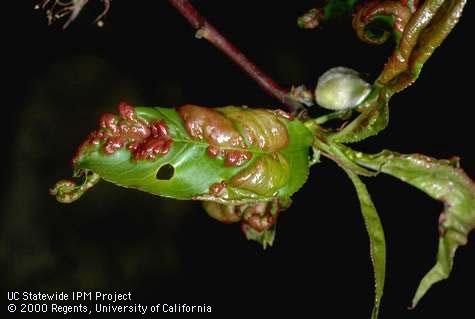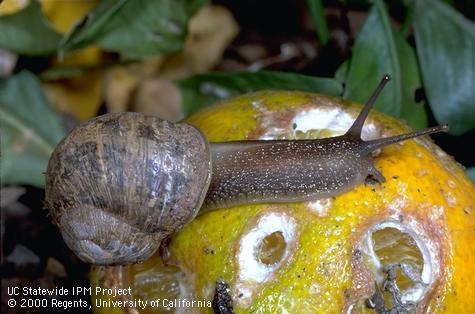
Posts Tagged: Landscape - General
Color Selection in the Bee Garden: A Few Examples
My last post covered the use of color in garden design from the perspective of what bees see. While aesthetics are important in any garden, the needs of bees come first at the Haven and other bee gardens. Here are a few examples of color combinations that are attractive to us and provide both...
Update on “organic” herbicide test for landscapes
A few months ago I wrote about starting some tests looking at various postemergence herbicides for non-crop use. This project was initiated due to new ordinances some cities in southern California were considering or adopted that limited the use products containing glyphosate on city owned...
Top 10 pests in gardens and landscapes and how to control them
Download the free booklet at the bottom of the page!
1. Ants

Most people deal with ants around their home at some point. Because most ants live outdoors, focus efforts on keeping ants from entering buildings by caulking entryways. Follow good sanitation practices to make your home less attractive to ants. Spraying ants inside the home will not prevent more ants from entering. Use baits to control the ant colony. Pesticide baits work by attracting worker ants who then take the poison back to the nest where the entire colony, including queens, can be killed. In the landscape, ants protect honeydew-producing pest insects from predators, so use sticky barriers or insecticide baits to keep ants out of trees and shrubs.
- Find out more at http://www.ipm.ucanr.edu/QT/antscard.html
2. Aphids

Aphids can curl leaves and produce sticky honeydew, but they rarely kill plants and you usually can wash them off with water. When aphid numbers get high, natural enemies such as lady beetles (lady bugs), lacewings, syrphid fly larvae, soldier beetles and others frequently feed on them, eliminating the need for pesticides. Protect these good bugs by avoiding the use of insecticides that can be toxic to a broad variety of insects. Ants protect aphids from these natural enemies, so keep ants away from your garden as well. When pesticides are necessary, use less toxic products such as insecticidal soaps and oils.
- Learn more about controlling aphids here: http://www.ipm.ucanr.edu/QT/aphidscard.html
3. Asian citrus psyllid and Huanglongbing disease

The Asian citrus psyllid (ACP) and the deadly bacterial disease it spreads, Huanglongbing (HLB), threaten citrus trees in backyards and on farms. There is no cure or effective control method for HLB disease. All types of citrus—including oranges, grapefruit, lemons, and mandarins—are affected as well as a few closely related ornamentals. ACP and HLB have already devastated the Florida citrus industry, and now that it is in the Western U.S. it is threatening the California citrus industry as well.
- See where the outbreaks are in California with our helpful Asian citrus psyllid website: http://ucanr.edu/sites/ACP/Distribution_of_ACP_in_California/
- Contact your agricultural commissioner's office, or call the California Department of Food and Agriculture (CDFA) Exotic Pest Hotline at 1-800-491-1899 to confirm a find. Learn more about ACP here: http://www.ipm.ucanr.edu/QT/asiancitruscard.html
4. Gophers

Gophers are small burrowing rodents that feed on roots of many types of plants. A single gopher can ruin a garden in a short time, and gopher gnawing can damage irrigation lines and sprinkler systems. In lawns, their mounds are unsightly and interfere with mowing. Early detection is critical to prevent damage. Use both traps and underground fencing to manage gopher problems. Toxic baits are available but can pose threats to wildlife, pets, and children, especially in backyard situations.
- Learn more about protecting your garden and landscape from gophers here: http://www.ipm.ucanr.edu/QT/gopherscard.html
5. Leaf-feeding caterpillars

Caterpillars, which are the larvae of butterflies and moths, damage plants by chewing on leaves, flowers, shoots, and fruit. Caterpillars in fruit or wood can be difficult to manage because they are hidden most of their life and can cause serious damage even when numbers are low. However, many plants, especially perennials, can tolerate substantial leaf damage, so a few leaf-feeding caterpillars often aren't a concern. Handpicking and beneficial predators and parasites often provide sufficient control. Look for feeding holes, excrement, webbed or rolled leaves, caterpillars, eggs, and good bugs.
- Learn more here:http://www.ipm.ucanr.edu/QT/lfcaterpillarscard.html
6. Peach leaf curl

Peach leaf curl is a fungal disease that affects only peach and nectarine trees. Distorted, reddened foliage in the spring is a distinctive symptom. New leaves and shoots thicken and pucker and later may die and fall off. An infection that continues untreated for several years can lead to a tree's decline. To prevent peach leaf curl, treat peach and nectarine trees with a copper fungicide every year after leaves fall. After symptoms appear in the spring, any treatment will not be effective. When planting new trees, consider buying peach tree varieties that are resistant to the disease.
- To learn more about preventing peach leaf curl click here: http://www.ipm.ucanr.edu/QT/peachleafcurlcard.html
7. Rats

Rats eat and contaminate food, garden produce, and fruit, and transmit diseases to humans and pets. Manage rats by removing food and shelter, eliminating entryways into buildings, and trapping. Snap traps are the safest, most effective, and most economical way to trap rats. For Norway rats, place traps close to walls, behind objects, in dark corners, and in places where you have found rat droppings. For roof rats, place traps in off-the-ground locations such as ledges, shelves, branches, fences, pipes, or overhead beams. Ensure traps are out of reach of children and pets.
- Learn more about preventing and controlling rats here: http://www.ipm.ucanr.edu/QT/ratscard.html
8. Scales

Scale insects suck plant juices and are pests of many trees and shrubs. Infestations can cause yellowing or premature dropping of leaves, sticky honeydew, and blackish sooty mold. Plant parts can distort or die back, depending on the species and abundance of scales. Most plants tolerate low to moderate numbers of scales. Provide plants with proper cultural care, especially irrigation. Encourage scale predators such as lady beetles or lacewings and look for parasite emergence holes in scale covers. Use sticky barriers or insecticide baits to selectively control scale-tending ants. Consider replacing problem-prone plants because most scales are highly specific to certain plants.
- Learn more about controlling scale populations here: http://www.ipm.ucanr.edu/QT/scalescard.html
9. Snails and slugs

These slimy mollusks emerge from hiding at night and chew holes in leaves and flowers of many succulent garden plants and fruit. Management requires a vigilant and integrated approach that includes eliminating moisture and hiding spots, trapping, setting up barriers, and handpicking. Regularly remove snails from shelters you can't eliminate such as low ledges on fences, undersides of decks, and meter boxes. Place traps in your garden and dispose of trapped snails and slugs daily. Reduce moist surfaces by switching to drip irrigation or watering in the morning rather than later in the day. Consider snail-proof plants such as impatiens, geraniums, begonias, lantana, nasturtiums, and many plants with stiff leaves and highly scented foliage such as sage, rosemary, and lavender.
- Learn more about controlling snails and slugs with and without pesticides in your garden here: http://www.ipm.ucanr.edu/QT/snailsslugscard.html
10. Weeds in landscapes

Prevent weed invasions in new beds with good site preparation. Keep weeds out with an integrated program that includes competitive plants, mulches, and hand removal. Be particularly vigilant about removing aggressive perennial weeds. You rarely should need herbicides in established landscape plantings. Mulches prevent weed seed germination by blocking sunlight. Remove small weeds by hand before they flower and set seed. Use shallow cultivation or hoeing to remove annual weeds from ornamental plantings. Only use herbicides for special-problem situations before establishing new plantings or for difficult-to-control perennial weeds.
- Learn more about controlling weeds in your landscape here: http://www.ipm.ucanr.edu/QT/landscapeweedscard.html
To see all of the University of California's Statewide Integrated Pest Management Program's information on home, garden, and landscape pests, visit http://www.ipm.ucanr.edu/PMG/menu.homegarden.html
For other short pest “Quick Tips” like the ten above, see http://www.ipm.ucanr.edu/QT/
To read even more in-depth, peer-reviewed information on many other common home and landscape pests in California, see the Pest Notes series at http://www.ipm.ucanr.edu/PMG/PESTNOTES/index.html
Download your free UC IPM Quick Tips Booklet of the Top Ten Pests in Gardens and Landscapes and How to Control Them with the link below!
Archaeology for All at Hopland REC
As one of the 9 UCANR Research and Extension Centers (RECs) across California, Hopland REC offers opportunities for research projects across a variety of disciplines particularly those requiring rangeland, oak woodland and chaparral environments. While respecting that need we also have the desire to behave as exemplary stewards of the land, setting examples and raising awareness as we change and improve our methods.
One important lesson that has allowed us to learn and spread knowledge has been from the history of our site. Dr. Donna Gillette has conducted research at HREC since 2006 when it became evident that some of the ancient petroglyph style markings to be found on the 5,358 acre site were likely to be over 2000 years old. Many of these markings take the form of circles carved into large rocks and are described as “Pecked, Curvilinear, Nucleated” markings (PCN's). Following Dr. Gillette's work we discovered that these markings were in fact between 5-8000 years old, pre dating Pomo culture (as we know it).
This fascinating research led us to ask questions about what kind of behavior is appropriate around such important discoveries. Can we touch these markings without degrading them further? Can we show them to the public? How do our Tribal partners feel about such finds? How do they affect land management decisions?
Our own journey led us to work more closely with our local Tribal Historic Preservation Officer (THPO), Shawn Padi of the Hopland Band of Pomo Indians. This partnership has most recently contributed to our “Archaeology for All” event, featuring both archaeologist Dr. Gillette and THPO's Shawn Padi and Hillary Renick on Saturday, October 10th. This event was planned in close collaboration with the Society for California Archaeology, the mini grant that we received enabled us to support the travel costs of our wonderful volunteer speakers, while the Hopland Band of Pomo Indians provided the lunch.
Over 100 members of the public and 30 children attended this event at which we discussed our local history, cultural markings that might be found on our landscape and why it is important to leave any discoveries of artefacts or markings just as you find them and report to your local THPO. Children got the chance to become archaeologists themselves and saw directly how difficult it can be to piece together our history when pieces of the story might have been removed or broken!
Piecing the past together – students try to put together the pieces of broken pottery they have located and mapped – it's not always easy when others have taken some of the pieces as keepsakes.
The challenge of balancing current demands from our natural resources and culturally important sites can be complex. However learning from the history of people in our area is a vital step in understanding sustainable use and behavior for the future. The Hopland Research and Extension Center have benefitted greatly from relationships such as those with local THPO's, their knowledge is integral future land management decisions.
Ever heard of fumitory?
This is a new-to-me weed, even though it's growing all around Robbins Hall where I've been working since typewriter times. Fumitory (Fumaria spp.) is a lacy, vine-like annual native to Europe. Looks sort of like parsley, though it's not related. It doesn't have tendrils, but it has 'grabby'...

